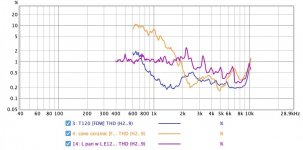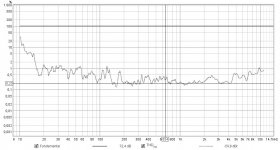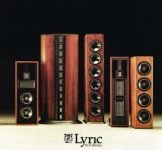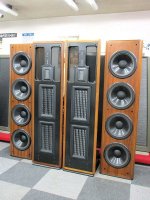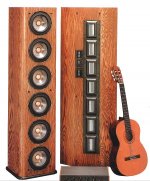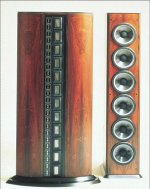I don't believe that planar magnetics will supplant ESL's. They are both fringe technologies, and the free market is deciding that in general they don't want either.
And ESL is inherantly a uniformly driven source, planar magnetics are not.
ESL diaphragms are much lighter and have less moving mass (2g for a set of 4 panel quads). This is both good and bad, as it impacts resonant frequency drastically.
ESL's have annoying drive requirements with high voltage power supplies and high drive voltages. Planar magnets are so much easier to deal with in that regard.
I could be wrong, but the distortion of ESL's is amongst the lowest drivers, and I don't think planar magnet is anywhere close. A set of quads is below 0.1% distortion above 300hz or so
Sheldon
And ESL is inherantly a uniformly driven source, planar magnetics are not.
ESL diaphragms are much lighter and have less moving mass (2g for a set of 4 panel quads). This is both good and bad, as it impacts resonant frequency drastically.
ESL's have annoying drive requirements with high voltage power supplies and high drive voltages. Planar magnets are so much easier to deal with in that regard.
I could be wrong, but the distortion of ESL's is amongst the lowest drivers, and I don't think planar magnet is anywhere close. A set of quads is below 0.1% distortion above 300hz or so
Sheldon
Distortion numbers from a complete rebuild ESL-63 set.
Measurement with REW RTA screen and MiniDSP UMIK-1
Indeed below 0,1% THD+N distortion @ 90 dB @ 1 meter.
This is left and right of both speakers from a set.

Can't really agree on annoying drive requirements.

According to some info on the web, you can/have to add 6 dB because of the fact that you are measuring a dipole and the microphone doesn't catch the audio impression that reaches your ears. No idea if this is fact or fiction.
Measurement with REW RTA screen and MiniDSP UMIK-1
Indeed below 0,1% THD+N distortion @ 90 dB @ 1 meter.
This is left and right of both speakers from a set.
Can't really agree on annoying drive requirements.
According to some info on the web, you can/have to add 6 dB because of the fact that you are measuring a dipole and the microphone doesn't catch the audio impression that reaches your ears. No idea if this is fact or fiction.
Thanks for good points to kick off the discussion.
Attached is plot of my old and tired ESL panels from 1975 (red), a $3 ceramic tweeter 40 yrs old (orange), and a high-end Foster planar T110 maybe 20 yrs old (blue). Tested medium loud. Tweeters N/A below maybe 3kHz.
Not saying the testing was esp careful, but what is what is.
Ben
Attached is plot of my old and tired ESL panels from 1975 (red), a $3 ceramic tweeter 40 yrs old (orange), and a high-end Foster planar T110 maybe 20 yrs old (blue). Tested medium loud. Tweeters N/A below maybe 3kHz.
Not saying the testing was esp careful, but what is what is.
Ben
Attachments
you can go as low as 100Hz, as some old IRS didAre the push-pull neodymium planars going to supplant the ESLs? Are the two thin-membrane technologies more or less equivalent for music systems? Aside from the cost of magnets, how low in frequency, can the planars go or are there inherent limitations?
Thanks.
Ben
more common is 150Hz
Attachments
With the neo-8's ????you can go as low as 100Hz, as some old IRS did
more common is 150Hz
ESL cells are somewhat constricted in size (surface area or shortest dimension), but cells can be pretty large and used in multiples for greater surface area. Film resonance not a big problem even if within the driver passband; so that's not an issue constraining size. How about planars?
ESL cells are cheap to mass produce and several cells (and even several speakers) can share a power supply. Can planars use electromagnets?
ESL cells are cheap to mass produce and several cells (and even several speakers) can share a power supply. Can planars use electromagnets?
Fully agree with that.
One problem with such a large full range panel is imaging. How is it going to create great imaging when highs are comming from wide and tall surface.
In normal cone speakers, highs are coming from tiny tweeter. Imaging is great.
Even Quad electrostats are not one full range area. They are multiway, with crossovers, and highs comming from the center, surrounded concentrically by mids, and furter bass panels. Like coaxials.
I never liked MartinLogan due to this fact. Large area emanates all frequencies. Imaging suffers.
One problem with such a large full range panel is imaging. How is it going to create great imaging when highs are comming from wide and tall surface.
In normal cone speakers, highs are coming from tiny tweeter. Imaging is great.
Even Quad electrostats are not one full range area. They are multiway, with crossovers, and highs comming from the center, surrounded concentrically by mids, and furter bass panels. Like coaxials.
I never liked MartinLogan due to this fact. Large area emanates all frequencies. Imaging suffers.
McGowan touches on this in a recent YouTube video discussing PS Audio's new flagship speaker replacing the IRS in their main corporate listening room. He suggested EMIMs generate double digit distortion at the operating lower end. Given their size, age and the performance achieved by Magnepan with the contemporary LRS this seems credible. Audio Science Review distortion results below.you can go as low as 100Hz, as some old IRS did
Attachments
There is SoundLAB as well making full range esl.
https://www.soundlabspeakers.com/ultimate/
https://www.soundlabspeakers.com/ultimate/
The issue with planers and going low is tension and the resulting resonant freq. The "neo" drivers have a farly tight diaphragm that plays hell with trying to cross over below about 150hz.
I believe the old Infinity planers had very little to no tension. This is fine when using multiples.
I believe the old Infinity planers had very little to no tension. This is fine when using multiples.
- Home
- Loudspeakers
- Planars & Exotics
- With planars, how low can you go?
